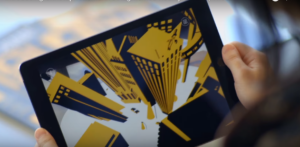Anyone familiar with The New Yorker Magazine may have noticed an interesting cover on the May 16 edition—a two-color drawing of a women stepping onto a subway car. It seems somewhat simple—not particularly eye-catching. But download an app called Uncovr (developed for The New Yorker), hold it over the magazine’s cover, and the image comes to life in your smart phone’s screen. Buildings grow off the page in 3-D form, music plays, city blocks rise up into the air, cars move around the streets. You can bring it in closer to zoom in among the buildings and see more detail, or bring it farther away for an overhead view. As long as you keep the screen anchored to the cover, an eye-popping video experience unfolds for the viewer.

This is Augmented Reality at its best. This older cousin of Virtual Reality has paved the way for the more immersive VR technology experiences through a Google Cardboard or a more expensive set of VR goggles like Oculus Rift or the Samsung Gear.
Augmented Reality is a live view of the physical environment that is augmented by computer-generated visuals. Virtual Reality, by contrast, replaces the real world with a digitally created one. Yet for marketers, they can go hand-in-hand. We’re huge fans of VR for digital marketing, and have produced a number of high-end experiences that bring customers into a virtual demonstration using state-of-the-art cameras and video editing. But new and better ways of leveraging Augmented Reality can play well along side of a VR campaign.
For marketers, this can mean an engaging way to preview a Virtual Reality campaign that can scale to as large of an audience as needed. Where VR videos require a set of goggles, Augmented Reality only needs a still graphic to key off of and an easy app download.

In The New Yorker’s example, the distribution model was simply the cover of the weekly publication. For CMOs at our enterprise clients, it can be a mailed postcard or one-pager, or it can be conveyed through a digital graphic via social media or an email. The image essentially serves as its own bar-code or QR code, bringing the experience to life. But rather than an obscure set of black bars and white spaces, the newer versions of Augmented Reality can anchor to a graphic representation that is part of the visual display, and leverages the motion-detecting software in the phone for changing viewing angles or for zooming in and out.
Augmented and Virtual Reality together deliver an amazing immersive experience that sets a marketing campaign far apart from the other noise in the market.
